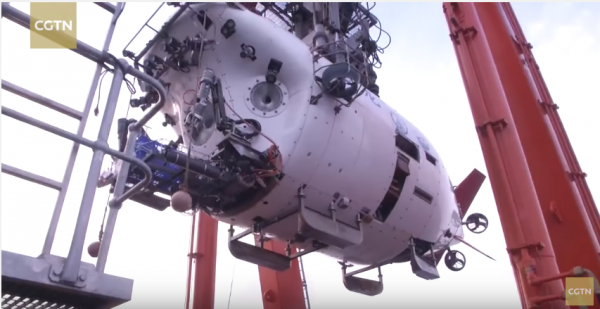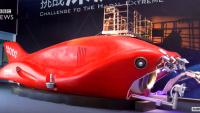China's Submersible 'Jiaolong' Finds Polymetallic Nodules in the South China Sea
| Prei Dy | | May 06, 2017 02:53 PM EDT |
(Photo : YouTube) China's Jiaolong retrieved a collection of polymetallic nodules in Puyuan Seamount from the South China Sea.
China's manned submersible Jiaolong has found a collection of polymetallic nodules in Puyuan Seamount in the disputed South China Sea.
"Learning the distribution of polymetallic nodules will help us to choose a site for experimenting with collection, which is one of the main goals of the mission," Wu Changbi, general commander of the second stage of the expedition, said.
Like Us on Facebook
The vessel, which is on the second stage of China's 38th ocean scientific expedition, was underwater for six and a half hours at a maximum depth of 2,029 meters.
Polymetallic nodules have over 10 kinds of elements such as cobalt, copper, iron, nickel, and manganese. Samples of seawater from near the seabed, sediment as well as high-definition photographs and video clips were also retrieved. The crew also brought back a sea lily and a branch of red coral in the sample of polymetallic nodules.
Jiaolong has also retrieved a basalt sample from the Zhenbei Seamount in the South China Sea. The vessel stayed for nine and a half hours underwater at a maximum depth of 2,930 meters beneath the sea surface.
The submersible was able to obtain a five-kilogram sample of basalt, some sediments, seawater near the seabed, and biosamples, as well as high-definition photos and videos.
"The valuable 'rock' will lay the foundation for our study of formation and evolvement of seamounts in the South China Sea during the Cenozoic period," Shi Xuefa, a researcher from the State Oceanic Administration, said. "It is very important for the study of the region's structural evolution."
Jiaolong, named after a mythical dragon, reached the deepest depth of Mariana Trench in June 2012 at 7,062 meters.
TagsSouth China Sea, Jiaolong, pollymetallic nodules, Puyuan Seamount
©2015 Chinatopix All rights reserved. Do not reproduce without permission
EDITOR'S PICKS
-

Did the Trump administration just announce plans for a trade war with ‘hostile’ China and Russia?
-

US Senate passes Taiwan travel bill slammed by China
-

As Yan Sihong’s family grieves, here are other Chinese students who went missing abroad. Some have never been found
-

Beijing blasts Western critics who ‘smear China’ with the term sharp power
-

China Envoy Seeks to Defuse Tensions With U.S. as a Trade War Brews
-

Singapore's Deputy PM Provides Bitcoin Vote of Confidence Amid China's Blanket Bans
-

China warns investors over risks in overseas virtual currency trading
-

Chinese government most trustworthy: survey
-

Kashima Antlers On Course For Back-To-Back Titles
MOST POPULAR
LATEST NEWS
Zhou Yongkang: China's Former Security Chief Sentenced to Life in Prison

China's former Chief of the Ministry of Public Security, Zhou Yongkang, has been given a life sentence after he was found guilty of abusing his office, bribery and deliberately ... Full Article
TRENDING STORY

China Pork Prices Expected to Stabilize As The Supplies Recover

Elephone P9000 Smartphone is now on Sale on Amazon India

There's a Big Chance Cliffhangers Won't Still Be Resolved When Grey's Anatomy Season 13 Returns

Supreme Court Ruled on Samsung vs Apple Dispute for Patent Infringement

Microsoft Surface Pro 5 Rumors and Release Date: What is the Latest?












